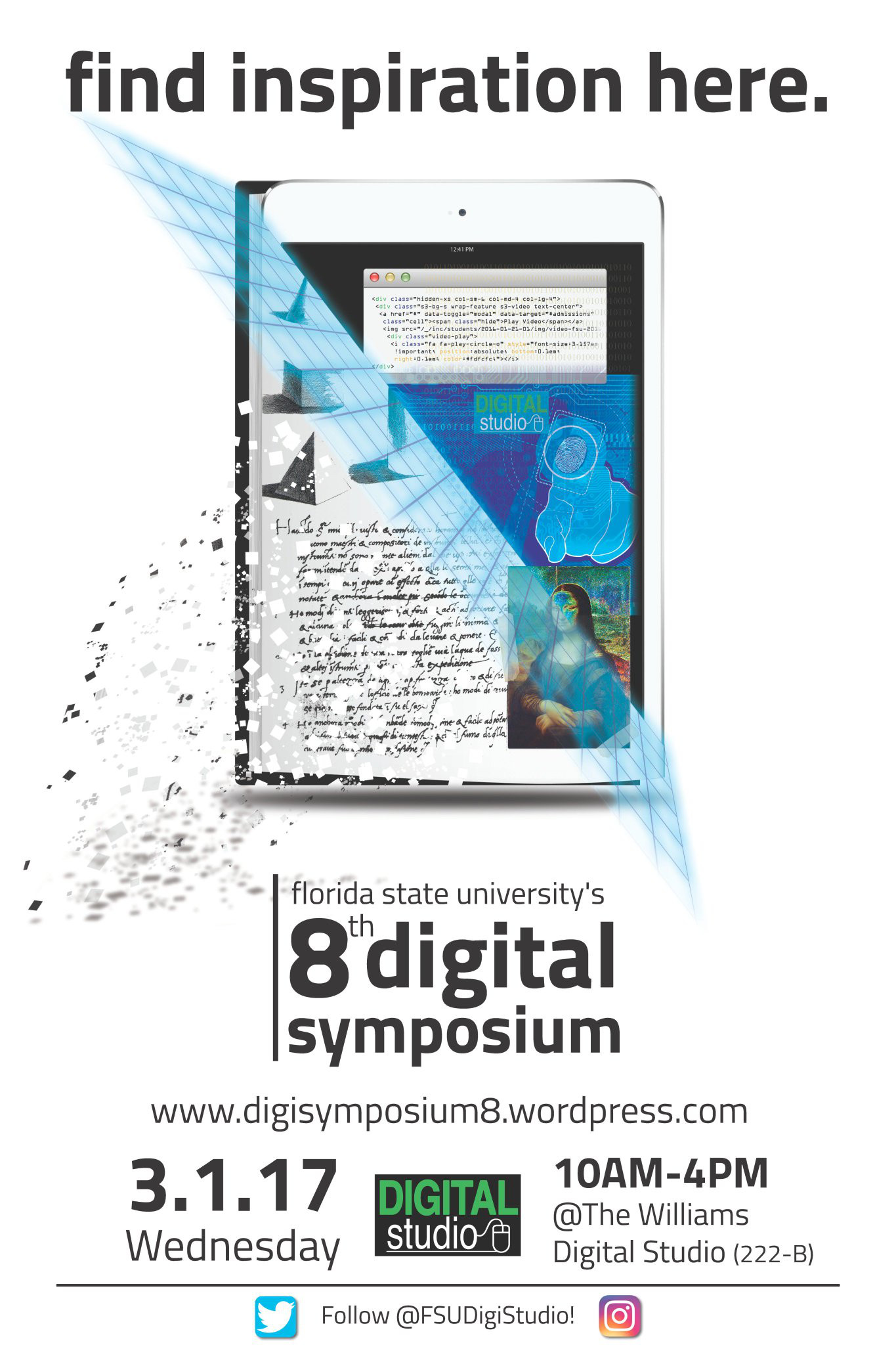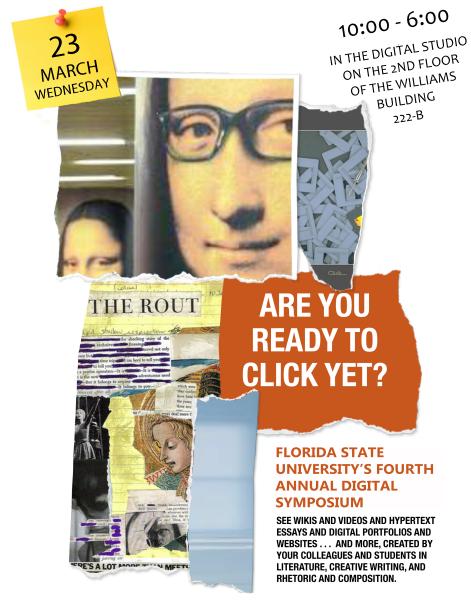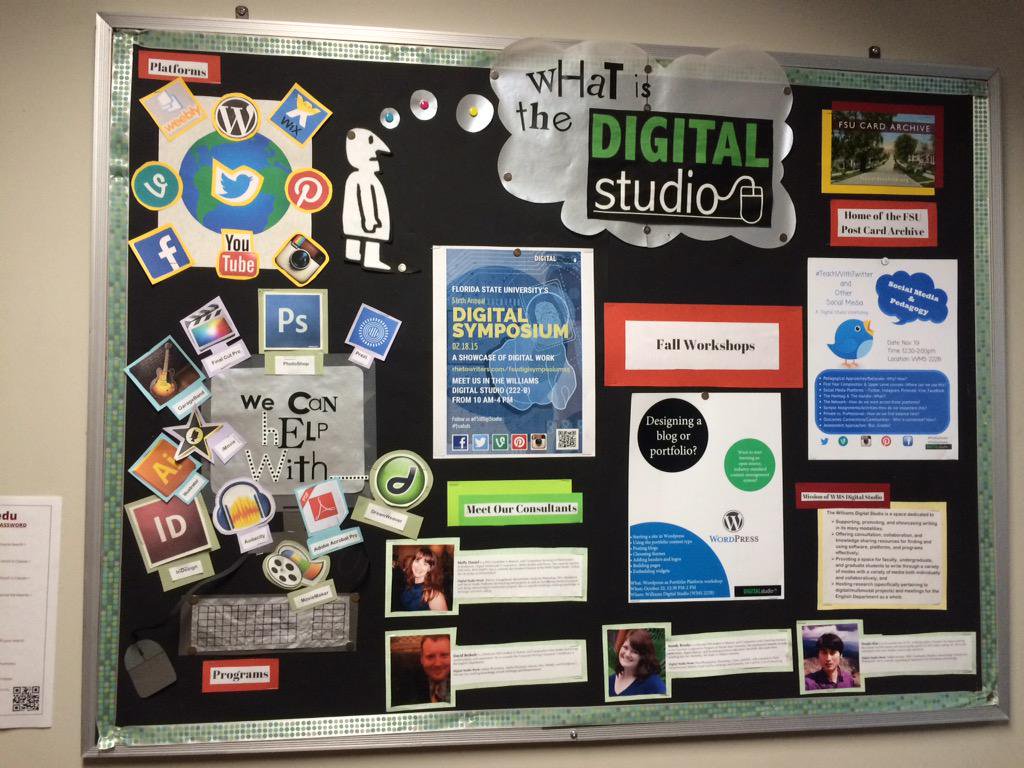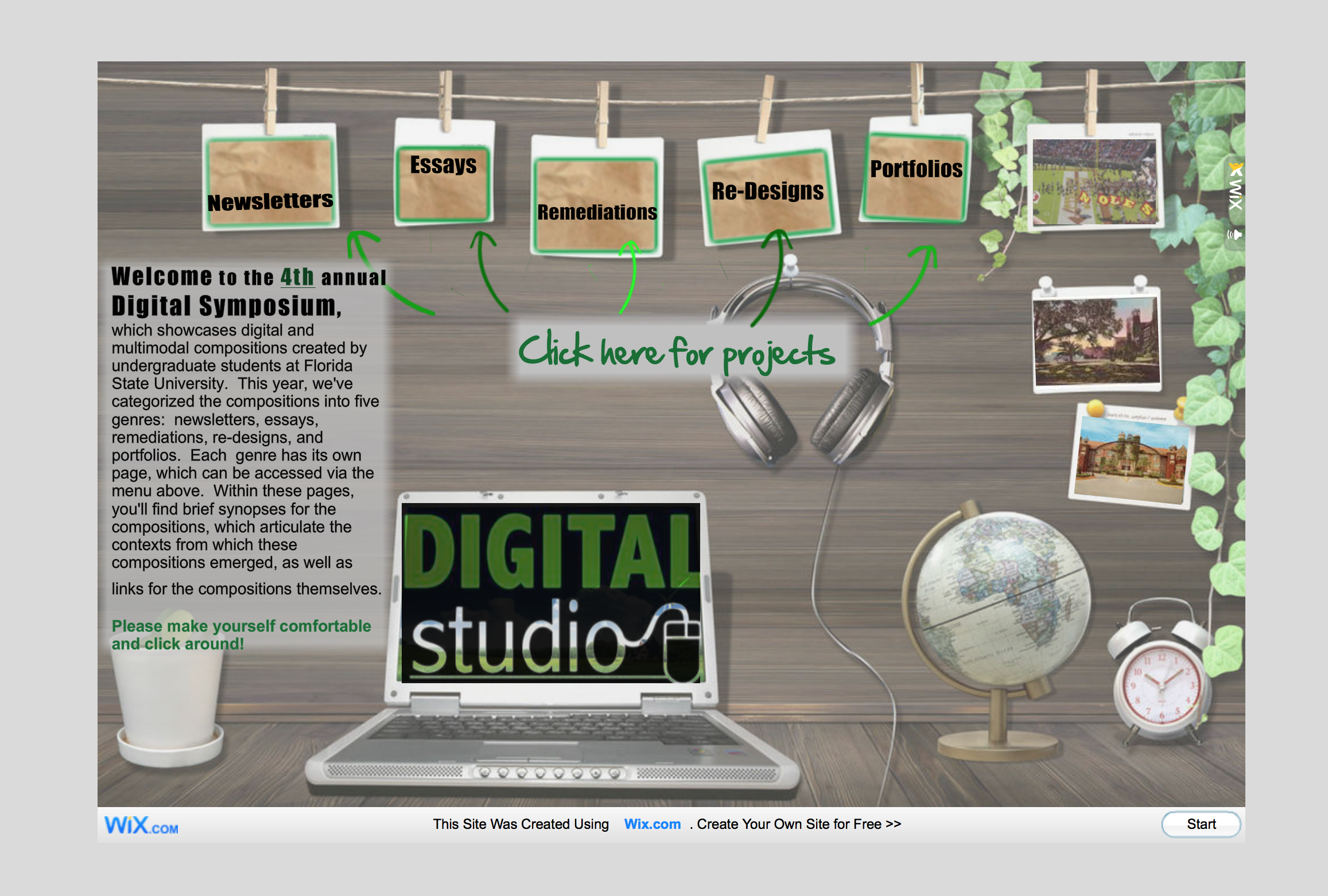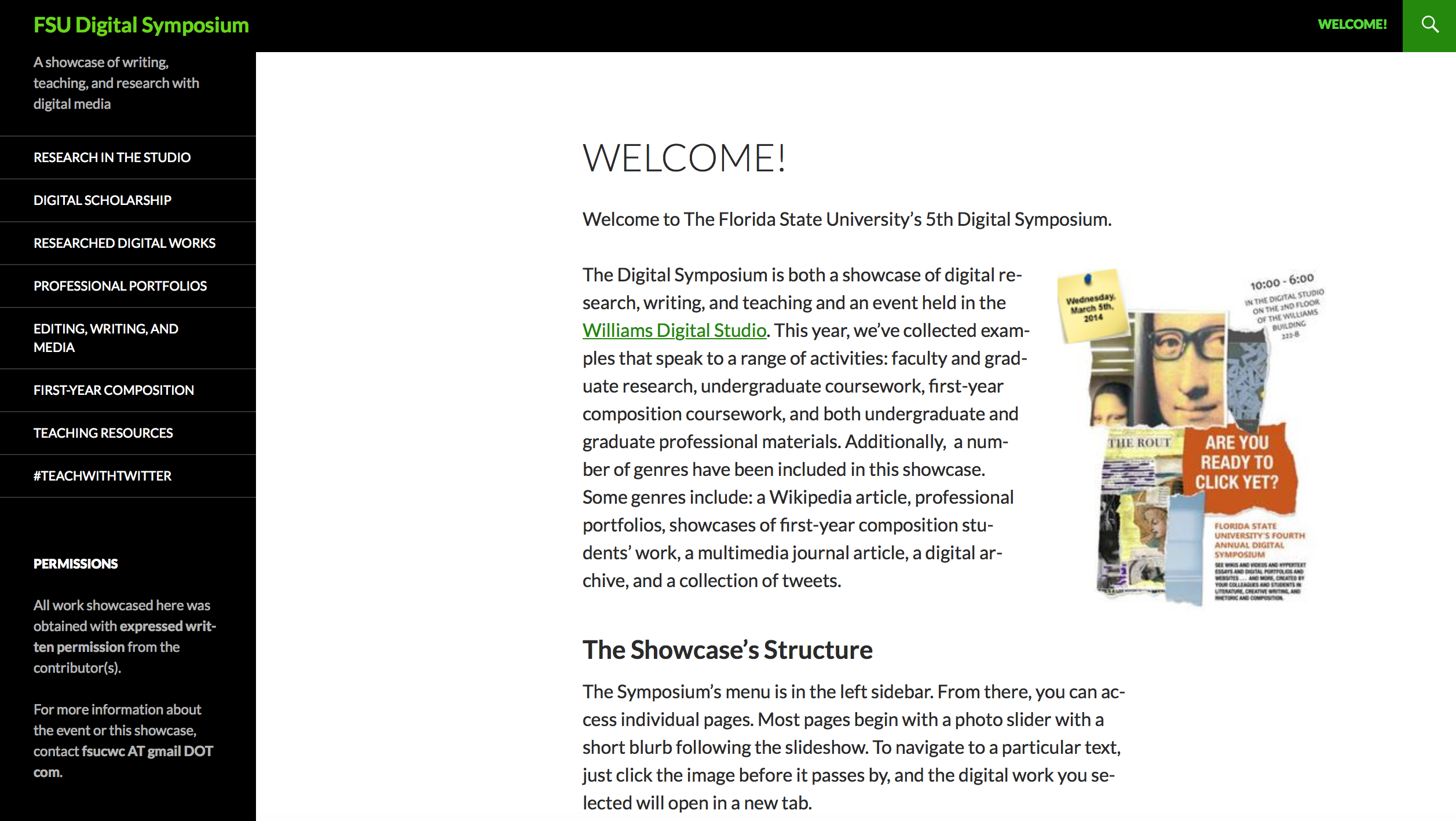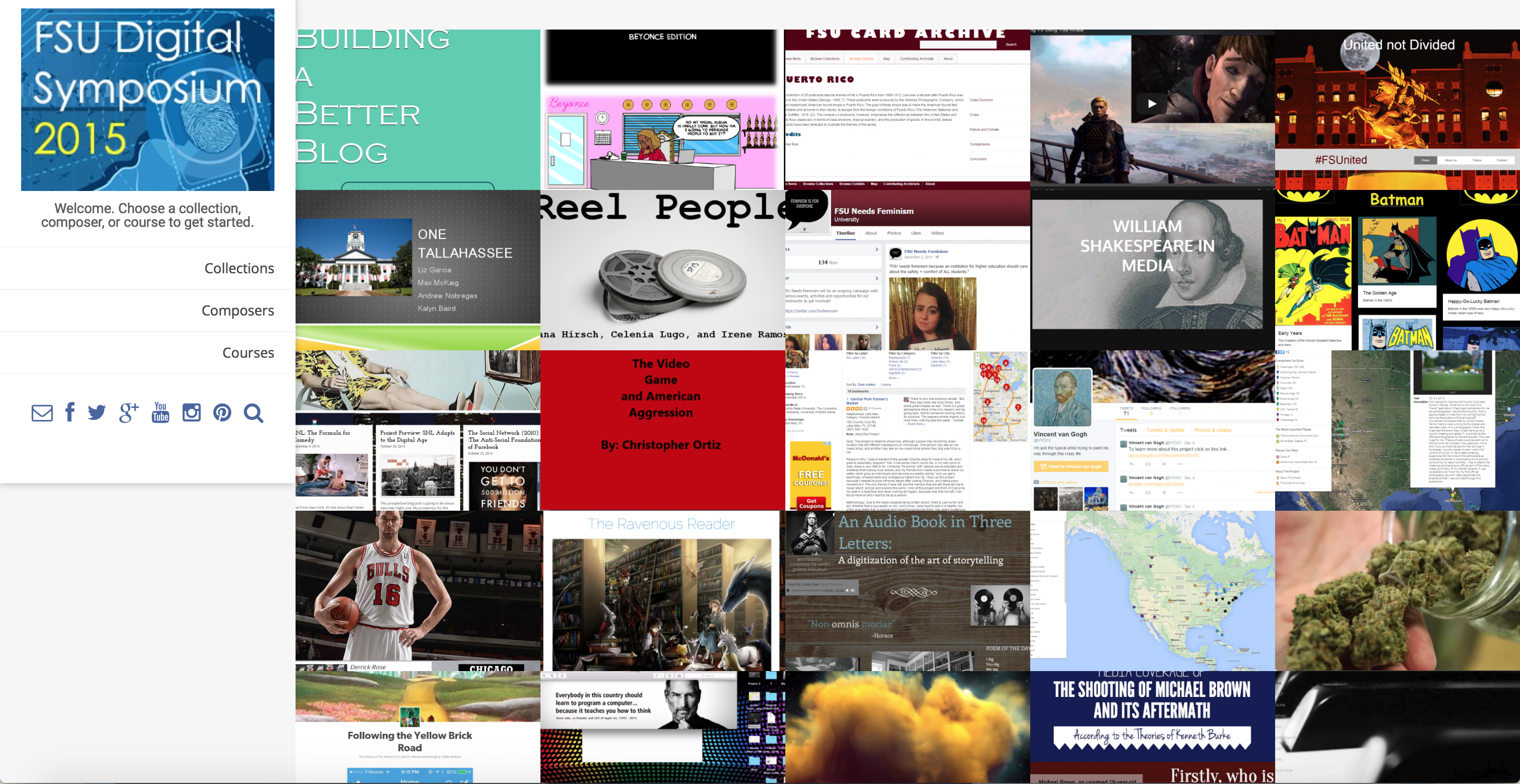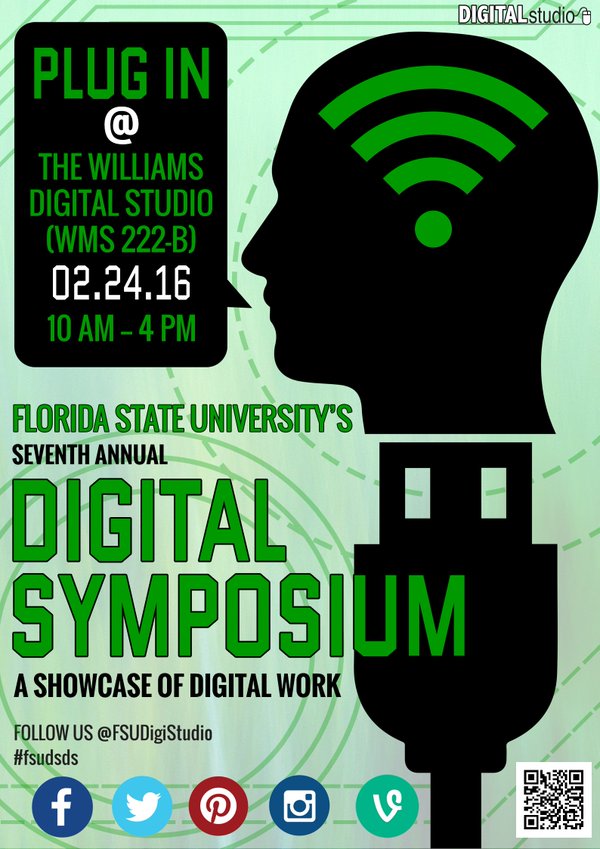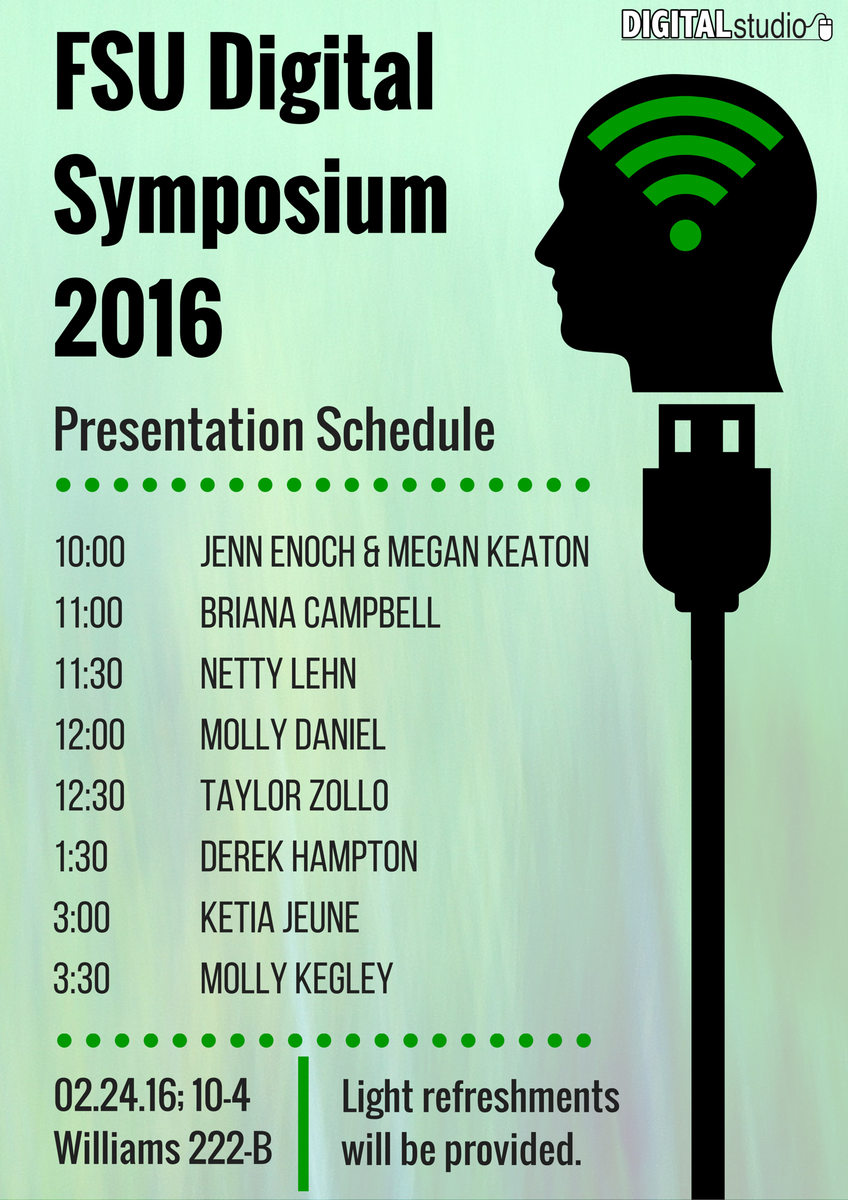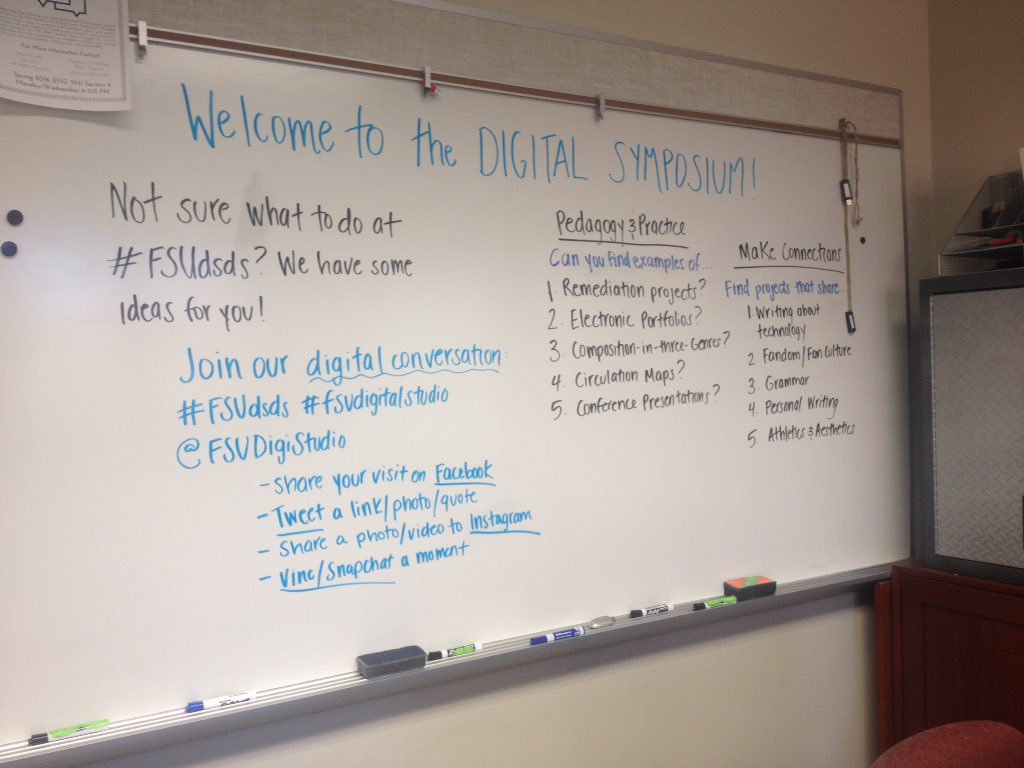Up to this point, we have historicized FSU’s Digital Symposium within the context of an evolving department by focusing on the Symposium’s role in two moments of stability in a changing institutional context. In the first part, we articulated the role of FSU’s Digital Symposium—specifically, the “Are You Ready to Click Yet?” event—in forming a disciplinary home for digital writing in a department rooted in and reflective of a print-centric culture. In the second part, we discussed the role of FSU’s Digital Symposium during the emergence of a parallel culture wherein digital writing and multimodal composition became valued and was considered central to teaching and research. It is our hope that these two parts in our discussion suggest how an event like FSU’s Digital Symposium can be useful to faculty working to initiate an interest in digital writing and digital pedagogy or to those faculty trying to make digital and multimodal composition a signature of their writing program. We also hope that our history may help faculty developing showcase events like FSU’s Digital Symposium avoid or mitigate some of our limitations, particularly those perceptions that digital writing, pedagogy, and research is exclusively the domain of Rhet-Comp.
Thus, to conclude, we provide four recommendations for those planning and administering a Digital Symposium-like event. In discussing each recommendation, we provide some practical guidelines for programs and departments that do not have FSU’s resources, which include a steady population of graduate students, opportunities for funding, and multiple writing programs supporting FSU’s Digital Symposium through a constant stream of student writing.
Faculty Champions
As former organizers of FSU’s Digital Symposium, we recommend first seeking out faculty champions—that is, powerful departmental figures who will support the event and its mission. This is especially important at other institutions where invested TAs are not available to help organize or drum up support for the event. As our history suggests, faculty champions such as Kathleen Blake Yancey, Michael Neal, and Kristie Fleckenstein were integral to the continued success of events like FSU’s Digital Symposium. Furthermore, and especially so if a primary goal is to help foster an integrated literacies culture, it’s beneficial to reach across programmatic and disciplinary boundaries in identifying faculty champions. At FSU, forming relationships with allies in other programs like Ned Stuckey-French and Stanley Gontarski in Literature proved invaluable in our efforts to recreate cross-program ties to broaden the audience of FSU’s Digital Symposium. And given this relationship, both faculty members have begun (or have resumed) assigning digital projects, have made regular use of FSU’s Digital Studio for their own work, and have encouraged their students to do the same. Through these programmatic relationships, our allies in Literature have bolstered the validity of digital pedagogy and scholarship to those outside of the Rhet-Comp and EWM programs who still hold print-centric views of textuality. Thus, as our own history developing and sustaining FSU’s Digital Symposium has suggested, encouraging and maintaining faculty buy-in across multiple programs benefits events and the stakeholders involved, helping ensure a more sustainable future for the Digital Symposium. In addition, cross-program participation provides a diverse and varied set of texts to showcase within the Symposium, therein offering a richer and more complete representation of the possibilities for digital teaching and digital scholarship. And through that more complete representation, events like FSU’s Digital Symposium can create opportunities for a more inclusive and varied conversation about the possibilities of including digital texts as part of teaching and scholarship.
Programmatic and Institutional Support
A more immediate set of concerns is that of resources and support. In addition to faculty champions, we’ve found that certain kinds of support are necessary for FSU’s Digital Symposium to continue to exist: funds, space, and personnel. In the early years of the Symposium, the English Department chair would try to find a small stipend for advertising. In recent years, departmental funding has mostly vanished, and as a result, Symposium organizers have had to be more creative in finding ways to promote the event. Because the Symposium is linked to the Digital Studio, Symposium organizers have used the Studio’s social media accounts—Facebook, Twitter, and Instagram—to promote the event for free via digital color flyers and social media blitzes.
Combined with word of mouth, this approach to promotion has been effective especially in combination with Bedsole’s approach of inviting students to present on their work included in the Symposium. Thus, we have found that the availability of funds doesn’t necessarily hinder or ensure the success of a Symposium, especially when entry-level—what Daniel Anderson has called “low bridge”—document design web apps like Canva and Piktochart as well as social media platforms like Twitter and Facebook can be made an integral part of promoting the event.
In terms of space, and as mentioned previously, FSU’s Digital Studio provides a space to host FSU’s Digital Symposium and the labor necessary to solicit work, compile the online showcase, and promote the event. Because the Digital Studio comes equipped with five computers, a laptop station, and a Smartboard, there are enough screens to display and invite attendees to click through the Symposium website. This relationship is mutually beneficial, as the Symposium functions as a promotional tool for the Digital Studio by showcasing the kinds of people who do digital work (often in the Studio), the kinds of programs involved in digital pedagogy and scholarship (ones tutors offer assistance in learning how to use), and the kinds of projects the Studio can help clients to produce. While making FSU’s Digital Symposium a responsibility of a rotating group of graduate students working in the Digital Studio has helped bolster the sustainability of the Symposium, this approach has indicated to us the importance of creating documentation to guide new organizers through the event rather than relying on descriptions from past organizers and local lore.
At institutions where there is not a steady stream of TAs responsible for organizing and hosting such an event, faculty—possibly in the context of a department events committee and/or a first-year writing committee—would need to supply the presence and effort necessary to solicit work, develop the showcase, and promote the event. Given the difficulties Symposium organizers have had appealing to a department- and college-wide audience, we imagine that, in a different institutional context where promoting a Digital Studio is not a key function of Symposium events or where spaces like the Digital Studio don’t exist to provide a venue, hosting in a more public space might be beneficial. Doing so provides an opportunity to circulate a story about writing as always-mediated and always-multimodal to a broader audience, and as noted previously, FSU’s Digital Symposium predates the launch of the Digital Studio, so access to a space like the Digital Studio is not prerequisite for launching and sustaining a showcase like the Digital Symposium. If hosted in well-traveled common areas like libraries, student centers, and meeting rooms, other digital symposia might draw a larger audience and mitigate the difficulties we had as Symposium organizers in changing the narrative that the Symposium was strictly a Rhet-Comp event, which can assist the attempts to foster an integrated literacies culture. If hosted outside of departmental spaces, we recommend that organizers structure their events like a bring-your-own-device (BYOD) digital poster session—one similar to the Digital Pedagogy Poster sessions at CCCC—where writers whose works have been included in the showcase are invited to present their submission on a device they bring with them.
FSU’s Digital Symposium has benefited over the years from the steady stream of graduate students whom faculty members could recruit to organize the showcase event. Most recently, organizing FSU’s Digital Symposium has fallen to a graduate student in the role of the CWC coordinator, adding to that person’s responsibilities of working in FSU’s Digital Studio and supporting new TA’s teaching in one of FSU’s CWCs. Acknowledging the reality that the presence of graduate students who can and want to organize an event like FSU’s Digital Symposium is a resource that is unique to a relatively small cross-section of institutions, we imagine other institutions might take an interdisciplinary approach to organizing an event like FSU’s Digital Symposium in order to secure a sustainable future for the event.
Recently, we have seen calls in the field for attention to sustainable digital research networks (Eyman, Sheffiend, & DeVoss, 2009; Selfe, Hawisher, & Berry, 2009), with special attention to building, growing, and assessing technology-rich graduate programs according to recognized frameworks and benchmarks. Among these calls, Patricia Ericsson’s (2009) “three-legged stool” approach to developing sustainable and technology-rich degree programs is especially useful for imaging how a digital symposium might take shape and what functions it might serve at institutions without a steady stream of graduate students. Among her three legs—the economic, ecologic, and social—the ecologic and the social suggest potential ways forward when an institution is not economically poised to dedicate a graduate student appointment to the organization of a digital symposium. As Ericsson notes, the ecologic, broadly considered in the context of a university, refers to an ecology of knowledge that is most readily seen through interdisciplinary and multi-disciplinary approaches to program design. In her discussion of the founding of a state-wide Electronic Media and Culture (EMC) program at Washington State University Campuses, Ericsson supplies a list of programs affiliated with the EMC programs:
such areas as language and culture (anthropology, writing, the history and theory of rhetoric, linguistics; cognition and learning) psychology, linguistics, education; language and society (anthropology, sociology, communications, rhetoric, political science); design and visual communications (fine arts); and information science. (8)
In addition to those disciplines Ericcson identifies whose interests overlap with the study of digital rhetoric and culture, we anticipate that disciplines like library sciences—especially where there is a public history and digital humanities focus—and marketing may be useful partners in developing a digital symposium event. Further, given the difficulties of FSU’s Digital Symposium to develop a broad appeal, recruiting stakeholders from a range of disciplines and departments from the beginning to organize the event may be beneficial for tapping a rich body of knowledge, interests, and experiences. Said otherwise, our first two recommendations potentially inform one another: that is, securing faculty champions, specifically from outside one’s program and/or department, can also be a gateway to securing programmatic and institutional support in terms of funds, space, and personnel.
In terms of the social leg of the sustainability stool, Ericsson imagines the social as referring to the ethical imperative of universities to create a socially just society:
It follows that the goals of a socially just university are to provide access to a diverse student population, to provide that students of all types have the opportunity to succeed within the university, and to equip students with the background and knowledge to succeed outside of the university.
A feature of FSU’s Digital Symposium has always been that organizers benefit from a marketable opportunity to work in a role complementary to WPA-work: working with faculty, students, and other administrators to collect artifacts; developing the showcase; and hosting the event. We imagine that undergraduate students—whether as part of a class, club, or internship—would likewise benefit from such an opportunity by providing them an experience that can be readily translated to prospective employers. Thus, while FSU’s Digital Symposium has benefitted from Rhet-Comp graduate students—and those graduate students have, to some degree, also benefitted from organizing the Symposium—we imagine recruiting students from across the university to organize an annual digital symposium will be of benefit to both the showcase through the inclusion of a rich and diverse set of materials and to the students organizing the Symposium. Particularly for those obtaining professional degrees like marketing or computer science, experience organizing an event like FSU’s Digital Symposium offers students the opportunity to develop “the analytical, expressive, and organizational abilities that a liberal arts degree can impart, along with a deep awareness of technology’s influences on contemporary communication” (Ericsson 2009, p. 7). And for those in humanities and the arts, that opportunity can be a marketable experience reflective of how liberal arts education transfers beyond the university.
The Preservation of Symposium Artifacts
Since its inception, FSU’s Digital Symposium has relied on free website building platforms like Wix and Wordpress to collect and curate artifacts included in the showcase, and more recently, given issues of funding, social media and document design platforms have been key in developing, organizing, and promoting the Symposium. While these low-bridge writing technologies have been indispensable to organizers by minimizing the need for technical expertise while creating opportunities for new engagements between attendees and the showcase, it has become increasingly obvious that it is important to consider preservation. Because generating enough interest to host FSU’s Digital Symposium was sometimes difficult, we did not always have an eye toward future preservation of showcases. As a result, many showcases from past Symposia and the artifacts they contained have not been preserved and are therefore gone. We acknowledge that to some extent perfect preservation is not possible because nothing prevents students from revising or deleting their projects after their projects have been included in a particular showcase. In other words, linkrot is inevitable, but this problem of preservation is only exacerbated when individual showcases are not archived from year to year. For several years, it was common practice for FSU’s Digital Symposium organizers to erase and rebuild showcases from one year to the next to abbreviate time spent web developing. Thus, while we continue to recommend the use of low bridge web-building platforms to develop the showcase website, we also recommend building in a procedure for the preservation of individual showcases and artifacts early. We have found that keeping a rolling list of links to past symposium on the departmental website has been a productive step to preserving past symposia, but preservation should go much further to curb to potential for linkrot. However, even this small measure has proven effective; whereas in the past only the most recent symposium has been accessible, teachers now have access to a set of four complete showcases to draw on when developing and teaching assignments.

